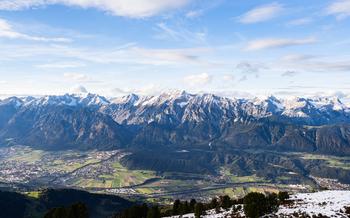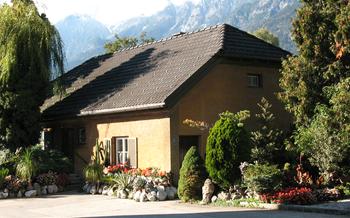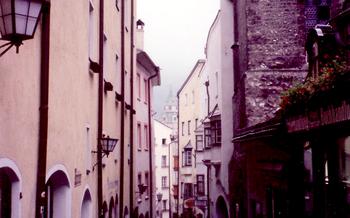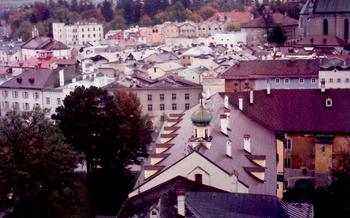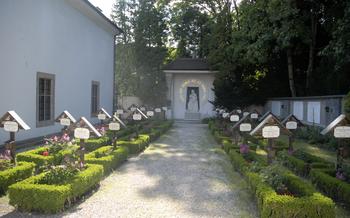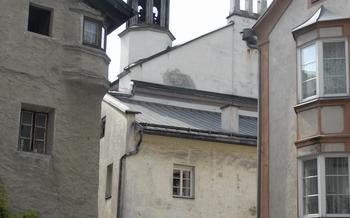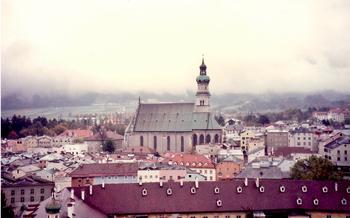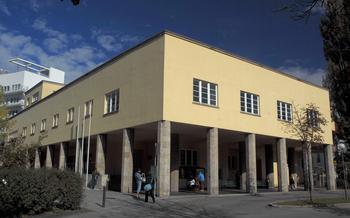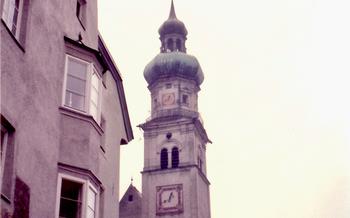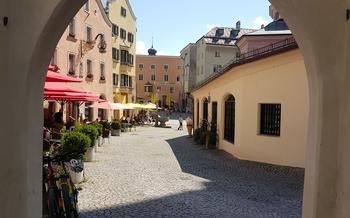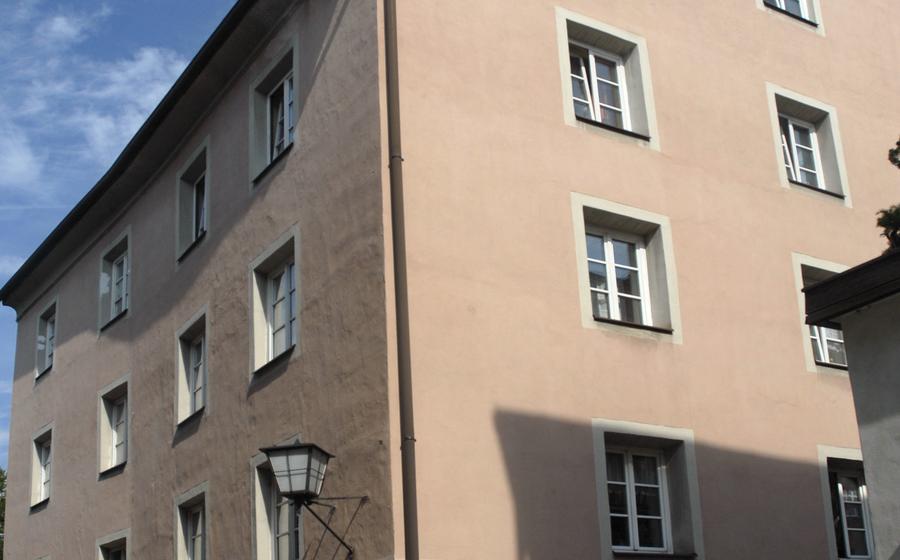
Almabtrieb Festival (seasonal)
- Hall in Tirol and the Almabtrieb Festival
- History and Significance
- Preparations for the Festival
- The Grand Procession
- Blessing of the Animals
- Music and Dance Performances
- Culinary Delights
- Crafts and Artisans
- Family-Friendly Activities
- Souvenirs and Shopping
- Photography and Videography
- Local Customs and Traditions
- Accommodation and Lodging
- Safety and Precautions
Hall in Tirol and the Almabtrieb Festival
Nestled among the scenic Tyrolean Alps, the charming town of Hall in Tirol is renowned for its vibrant cultural heritage and breathtaking natural beauty. One of the highlights of the town's annual calendar is the Almabtrieb Festival, a jubilant celebration marking the return of cattle from their summer pastures high in the mountains. This traditional festival, deeply rooted in Tyrolean customs, offers a unique opportunity to immerse oneself in the region's rich history, vibrant traditions, and warm hospitality.
The Almabtrieb Festival, also known as the Cattle Drive Festival, is held annually in mid-September, when the summer grazing season comes to an end. This festive occasion symbolizes the safe return of the cattle and the bounty they bring, ensuring the community's prosperity and sustenance throughout the upcoming winter months.
Getting to Hall in Tirol is a breeze, with various transportation options available. The town is well-connected by road and rail, with regular bus and train services from major cities in Austria and neighboring countries. For those traveling by car, Hall in Tirol is easily accessible via the A12 Inntal Autobahn, ensuring a scenic and convenient journey to this Tyrolean gem.
History and Significance
The Almabtrieb Festival has its roots in the agricultural traditions of the Tyrolean region. In the past, farmers used to take their cattle to graze on the lush mountain pastures during the summer months. As autumn approached and the weather turned colder, the animals were brought back down to the valley for the winter. This event, known as the Almabtrieb, or "cattle drive," was a significant occasion for the community, marking the end of the grazing season and the return of the animals to their home villages.
Over time, the Almabtrieb evolved into a festive celebration, symbolizing gratitude for the safe return of the cattle and the bounty they provided. The festival became a way for the community to come together, celebrate their agricultural heritage, and honor the hard work and dedication of the farmers.
Today, the Almabtrieb Festival retains its cultural and traditional significance. It serves as a reminder of the region's agricultural roots, while also providing an opportunity for locals and visitors to celebrate the beauty of the Tyrolean landscape, the importance of animal husbandry, and the resilience of the Tyrolean people.
Preparations for the Festival
Weeks before the grand event, the preparations for the Almabtrieb Festival begin in earnest. Farmers start herding their cattle down from the lush mountain pastures, where they have spent the summer grazing. These animals have been roaming freely in the alpine meadows, enjoying the fresh air, abundant vegetation, and panoramic views. Now, it's time for them to return to the valley and reunite with their owners.
The animals are carefully cleaned and groomed to ensure they look their best for the festival. Their coats are brushed, their hooves are trimmed, and they are adorned with colorful ribbons and bells. Elaborate headdresses, crafted from flowers and other natural elements, are placed on their heads, adding a touch of festivity to their appearance.
Traditional costumes and accessories are prepared by the participants. Dirndls and lederhosen, the iconic attire of Tyrol, are worn with pride. These garments are often adorned with intricate embroidery, showcasing the region's rich craftsmanship. Hats, scarves, and other accessories complete the traditional ensemble.
The festival grounds are transformed into a vibrant spectacle. Decorations, such as colorful flags, bunting, and flowers, are hung throughout the streets and squares. Stages are set up for music and dance performances, while food stalls and vendors prepare to offer a tempting array of local delicacies. The entire town buzzes with excitement as the countdown to the festival begins.
The Grand Procession
The highlight of the Almabtrieb Festival is the grand procession, which takes place on the final day of the event. The procession features elaborately decorated cattle, farmers, and locals parading through the streets of Hall in Tirol. The route of the procession winds through the historic city center, showcasing the town's charming architecture and vibrant atmosphere.
Participants in the procession dress in traditional Tyrolean costumes, adding to the festive ambiance. The animals are adorned with colorful garlands, flowers, and bells, creating a visually stunning spectacle. Music and dance groups accompany the procession, playing lively Tyrolean tunes and performing traditional dances. The infectious energy and camaraderie among participants create an unforgettable atmosphere that captivates both locals and visitors alike.
Blessing of the Animals
At the heart of the Almabtrieb Festival lies a deeply religious ceremony: the blessing of the animals. This solemn event holds immense significance for the farmers and their livestock, who seek divine protection and good fortune for the coming year. The local priest or religious figure plays a pivotal role in conducting the blessing, invoking divine grace upon the animals and their owners.
The blessing ceremony is steeped in symbolism and tradition. The animals, adorned with intricate garlands and flowers, are paraded before the priest, who recites prayers and sprinkles holy water upon them. This act of benediction symbolizes the community's gratitude for the animals' contributions to their livelihoods and way of life.
The blessing extends beyond the physical well-being of the animals; it also encompasses their spiritual well-being. The farmers believe that the blessing protects their livestock from harm, disease, and misfortune, ensuring a prosperous and bountiful year ahead.
The ceremony culminates in a collective prayer, where the farmers and spectators join hands in supplication, seeking divine guidance and protection for their animals and their community. The blessing of the animals at the Almabtrieb Festival is a testament to the deep spiritual connection between the Tyrolean people and their livestock, a bond that has endured for generations.
Music and Dance Performances
The Almabtrieb Festival is not just about the animals; it's also about celebrating Tyrolean culture through music and dance. Traditional Tyrolean music groups fill the air with lively tunes, inviting everyone to join in the merriments. The infectious energy and festive spirit are palpable as participants and spectators dance to the rhythm of the music.
Local dance groups showcase their intricate choreography and colorful costumes, adding to the visual spectacle of the festival. The performances are not just for entertainment but also a way to preserve and promote Tyrolean traditions. Whether you're a seasoned dancer or simply want to let loose and have fun, the Almabtrieb Festival offers an unforgettable musical and dance experience.
Insider Tip: If you're a fan of traditional Tyrolean music, make sure to arrive early to secure a spot near the stage. You'll have the best view of the performances and the chance to join in the dancing.
Culinary Delights
At the Almabtrieb Festival, visitors can indulge in a feast of local delicacies and specialties. Food stalls and vendors line the streets, offering a tempting array of Tyrolean dishes, each with its own unique story and significance. From hearty stews and grilled meats to freshly baked pastries and sweet treats, there's something to satisfy every palate.
Must-Try Dishes:
Tiroler Gröstl: A traditional Tyrolean dish made with potatoes, onions, and meat, pan-fried and served with a fried egg.
Käsespätzle: Egg noodles tossed in melted cheese, often served with caramelized onions and bacon.
Schlutzkrapfen: Half-moon-shaped dumplings filled with spinach, ricotta cheese, and herbs, served with melted butter and poppy seeds.
Tiroler Kiachl: Sweet pastries made with yeast dough and filled with jam, quark cheese, or apples, served with powdered sugar.
Kaiserschmarrn: Shredded pancakes served with powdered sugar and fruit compote.
Crafts and Artisans
The Almabtrieb Festival is not merely a celebration of the return of the cattle; it is also a showcase of traditional Tyrolean craftsmanship. Local artisans gather at the festival to exhibit and sell their handmade creations, transforming the event into a vibrant marketplace of local talent.
Stalls and workshops line the festival grounds, each showcasing a unique aspect of Tyrolean craftsmanship. Visitors can marvel at intricate wood carvings, delicate lacework, hand-painted ceramics, and skillfully crafted jewelry. The artisans, passionate about their craft, often demonstrate their techniques, allowing visitors to witness the skill and dedication required to create these beautiful works of art.
These traditional handicrafts hold deep cultural significance, representing centuries of Tyrolean heritage. The intricate patterns and motifs used in wood carvings and embroidery often symbolize elements of nature, such as flowers, animals, and mountains, reflecting the region's strong connection to its surroundings.
By supporting these local artisans, visitors not only take home a unique souvenir but also contribute to the preservation of Tyrolean traditions. Each handcrafted item represents a piece of the festival's cultural heritage, allowing visitors to carry a piece of the Almabtrieb experience back home with them.
Family-Friendly Activities
The Almabtrieb Festival is not just for adults; it's a joyous occasion for the whole family. Children are welcomed with open arms, and there are plenty of activities to keep them entertained throughout the day.
Games and rides are set up for the little ones, providing them with hours of fun and excitement. Face painting and balloon animals add to the festive atmosphere, transforming the festival grounds into a magical wonderland. Designated areas for families and children ensure that they have a safe and comfortable space to enjoy the festivities.
The Almabtrieb Festival is a celebration that embraces all age groups. From the colorful procession to the lively music and dance performances, there's something for everyone to enjoy. It's an opportunity for families to come together, create lasting memories, and experience the rich cultural heritage of Hall in Tirol.
Souvenirs and Shopping
The Almabtrieb Festival presents a unique opportunity to take home a piece of the Tyrolean tradition and culture. Local artisans and vendors set up stalls showcasing a variety of handmade crafts and souvenirs. Visitors can find traditional Tyrolean handicrafts, such as wood carvings, pottery, and textiles, as well as festival merchandise, including t-shirts, hats, and other memorabilia. Local specialties, such as Tyrolean cheese, sausages, and honey, are also available for purchase. These souvenirs not only serve as mementos of the festival but also support the local economy and artisans.
Photography and Videography
The Almabtrieb Festival presents a kaleidoscope of vibrant colors, captivating performances, and stunning visuals. Capturing these moments through photography and videography not only serves as a cherished memento but also allows you to share the festival's magic with others.
Plan Your Shots:
- Arrive early to scout the best vantage points along the procession route.
- Identify spots with a clear view of the animals, costumes, and performances.
- Consider using a tripod for stability and to avoid shaky footage.
Capture the Details:
- Zoom in on the intricate details of the animals' decorations, the traditional costumes, and the festive atmosphere.
- Experiment with different angles and perspectives to create unique and dynamic shots.
- Don't forget to capture the smiles, laughter, and emotions of the participants.
Embrace the Movement:
- Use panning techniques to follow the movement of the procession and create a sense of dynamism.
- Capture the energy of the dancers and performers as they showcase their skills.
- Experiment with slow-motion or time-lapse photography to add a creative touch to your visuals.
Tell a Story:
- Think beyond individual shots and try to tell a visual story of the festival.
- Capture the journey of the animals from the mountain pastures to the festival grounds.
- Document the preparations, the procession, the blessing, and the celebrations.
Share Your Creations:
- Share your photos and videos on social media using relevant hashtags to connect with other festival enthusiasts.
- Create a blog post or online album to showcase your work and share your experiences with the world.
- Consider submitting your best shots to local photography competitions or exhibitions.
Local Customs and Traditions
The Almabtrieb Festival is deeply rooted in Tyrolean culture and traditions. It is a celebration of the region's agricultural heritage and the bond between humans and animals. To fully appreciate the festival's significance, it is essential to understand the local customs and traditions associated with it.
Respecting Local Customs and Etiquette: When attending the festival, it is important to be respectful of local customs and etiquette. This includes dressing modestly, avoiding loud noises or disruptive behavior, and showing consideration for the animals and their owners. It is also customary to greet locals with a friendly "Grüß Gott" (May God greet you) or "Servus" (Hello).
Interacting with Locals and Learning about Their Traditions: One of the best ways to experience the Almabtrieb Festival is to interact with locals and learn about their traditions. Attend the festival with a local guide or strike up conversations with friendly Tyroleans. Ask questions about the history, symbolism, and rituals associated with the event.
Embracing the Tyrolean Way of Life: The festival offers a unique opportunity to embrace the Tyrolean way of life. Participate in traditional dances, sample local delicacies, and enjoy the infectious energy of the Tyrolean people. Immerse yourself in the festival's atmosphere and let the spirit of Tyrol take hold.
Understanding the Cultural Significance of the Festival: The Almabtrieb Festival is more than just a celebration; it is a reflection of Tyrolean identity and heritage. By understanding the cultural significance of the festival, visitors can gain a deeper appreciation for the region's history and traditions.
Accommodation and Lodging
Hall in Tirol and its surroundings offer a range of accommodation options to suit different budgets and preferences. From cozy guesthouses and charming bed and breakfasts to comfortable hotels and modern apartments, there's something for every traveler.
To ensure a hassle-free stay, it's advisable to book your accommodation in advance, especially if you're visiting during the peak tourist season or coinciding with the Almabtrieb Festival. Online booking platforms and local tourist information offices can assist you in finding suitable options.
For budget-conscious travelers, there are several hostels and guesthouses that offer affordable shared or private rooms. These accommodations often provide a communal kitchen and common areas, allowing you to meet fellow travelers and share stories.
If you prefer a more private and comfortable experience, consider booking a hotel room or an apartment. Hotels in Hall in Tirol range from traditional family-run establishments to modern chains, offering amenities such as private bathrooms, breakfast buffets, and stunning mountain views.
When selecting your accommodation, consider factors such as location, proximity to the festival grounds, and amenities that are important to you. Whether you're seeking a rustic charm or modern conveniences, Hall in Tirol has something to offer every traveler.
Safety and Precautions
The Almabtrieb Festival is generally a safe and well-organized event, but it's essential to take precautions to ensure a smooth and enjoyable experience. Here are some tips for staying safe during the festival:
-
Navigate Crowds Safely: The festival attracts a large number of visitors, so be prepared for crowds, especially during the procession. Stay aware of your surroundings, keep an eye on your belongings, and avoid pushing or shoving.
-
Secure Valuables: Keep your valuables, such as money, credit cards, and travel documents, safe and secure. Consider using a money belt or a secure bag that you can keep close to your body.
-
Follow Local Regulations and Guidelines: Respect local regulations and guidelines, such as traffic rules and alcohol consumption limits. Be mindful of the rights and safety of others, and avoid any behavior that may cause harm or disruption.
-
Be Aware of Potential Risks: While the festival is generally safe, be aware of potential risks such as pickpocketing, petty theft, and alcohol-related incidents. Stay vigilant, avoid walking alone at night, and report any suspicious activity to the authorities.
By following these safety tips, you can help ensure a safe and enjoyable experience at the Almabtrieb Festival.
